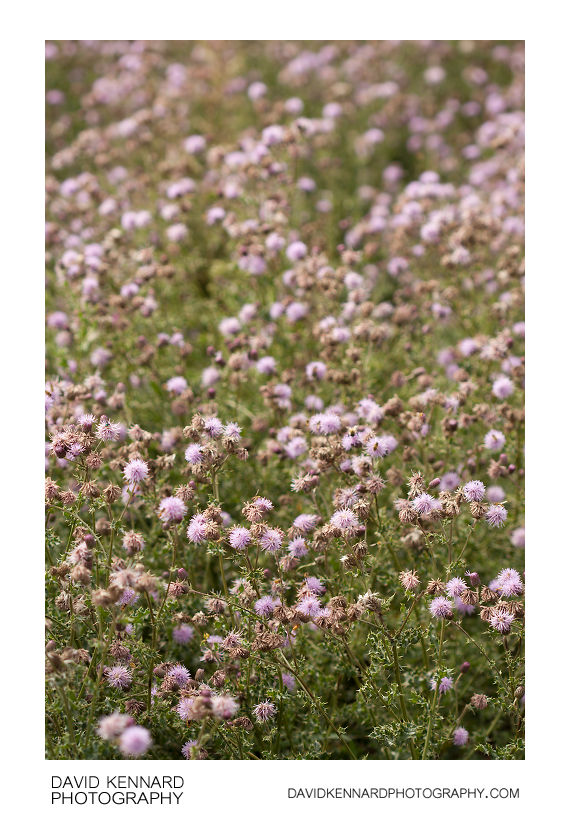Creeping Thistle (Cirsium arvense)

Description
- Title:
- Creeping Thistle (Cirsium arvense)
- Caption / Description:
-
Cirsium arvense is a species of Cirsium, native throughout Europe and northern Asia, and widely introduced elsewhere. The standard English name in its native area is Creeping Thistle.
It is a herbaceous perennial plant growing 30–100 cm, forming extensive clonal colonies from an underground root system that sends up numerous erect stems each spring, reaching 1–1.2 m tall (occasionally more).
Stems are green smooth and glabrous (having no Trichome or glaucousness), mostly without spiny wings. The stems often lie partly flat by summer but can stay erect if supported by other vegetation. The leaves are very spiny, lobed, up to 15–20 cm long and 2–3 cm broad (smaller on the upper part of the flower stem).
The inflorescence is 10–22 mm diameter, pink-purple, with all the florets of similar form (no division into disc and ray florets).The flowers are usually dioecious, but not invariably so, with some plants bearing hermaphrodite flowers. The seeds are 4–5 mm long, with a feathery pappus which assists in wind dispersal. The plant also spreads underground using rhizomes.
The seeds are an important food for Goldfinch and Linnet, and to a lesser extent for other finches. Creeping Thistle foliage is used as a food by over 20 species of Lepidoptera, including the Painted Lady butterfly and the Engrailed, a species of moth, and several species of aphids.
Description adapted from Wikipedia: http://en.wikipedia.org/wiki/Cirsium_arvense
- Tags / Keywords:
-
- Europe
- UK
- Britain
- England
- East Midlands
- Leicestershire
- Biota
- Life
- Vitae
- Eukaryota
- Purple
- Plantae
- Plants
- Magnoliophyta
- Flowering Plants
- Angiosperms
- Magnoliopsida
- Dicotyledons
- Asteraceae
- Asterales
- Asters
- Compositae
- Daisies
- Sunflowers
- Great Easton
- Cirsium
- Plume Thistles
- Cirsium arvense
- Creeping Thistle
- Common Field Thistle
Admin
- Date Original Photo Taken:
- Original File Name:
- _MG_8394.CR2
- Event:
- Rating:
- ☆
- Date this image added/last updated on website:
- Original File Dimensions:
- 2848px x 4272px
- File Type:
- JPEG
- Color Mode:
- Original Image Color Profile:
- Adobe RGB (1998)
Location
- Location Shown:
-
- Sublocation:
- City:
- Great Easton
- Province/State:
- Leicestershire
- Country:
- United Kingdom
- World Region:
- Europe
- Location Created:
-
- Sublocation:
- City:
- Great Easton
- Province/State:
- Leicestershire
- Country:
- United Kingdom
- World Region:
- Europe
- Geo-location:
- 52.555551666667, -0.77294833333333 View on map
Rights
- Copyright Status:
- Copyrighted
- Licensing Status:
- Rights Managed
- Available for Editorial Use:
- Yes
- Available for Commercial Use:
- No
- Copyright Notice:
- © 2011 Dave Kennard
Camera Data
- Date Digital Resource was created:
- Shutter speed:
- 1⁄640 s
- Aperture:
- f/3.5
- Camera Model:
- Canon EOS 450D
- ISO:
- 100
- Exposure Compensation:
- 0
- Focal Length:
- 100mm
- Focal Length (35mm equiv.):
- Metering Mode:
- Center-weighted average
- Flash:
- Off, Did not fire
- Exposure Mode:
- Auto
- White Balance:
- Manual
- Light Source:
- Exposure Program:
- Aperture-priority AE
Additional shooting metadata
- Lens:
- Canon EF 100mm F2.8 Macro USM
- Filters used:
- Additional Optics used:
- Setup:
- Handheld, Liveview
Post Processing
- Image Modified:
- Software used:
-
- Adobe Camera RAW
- Post Processing:
